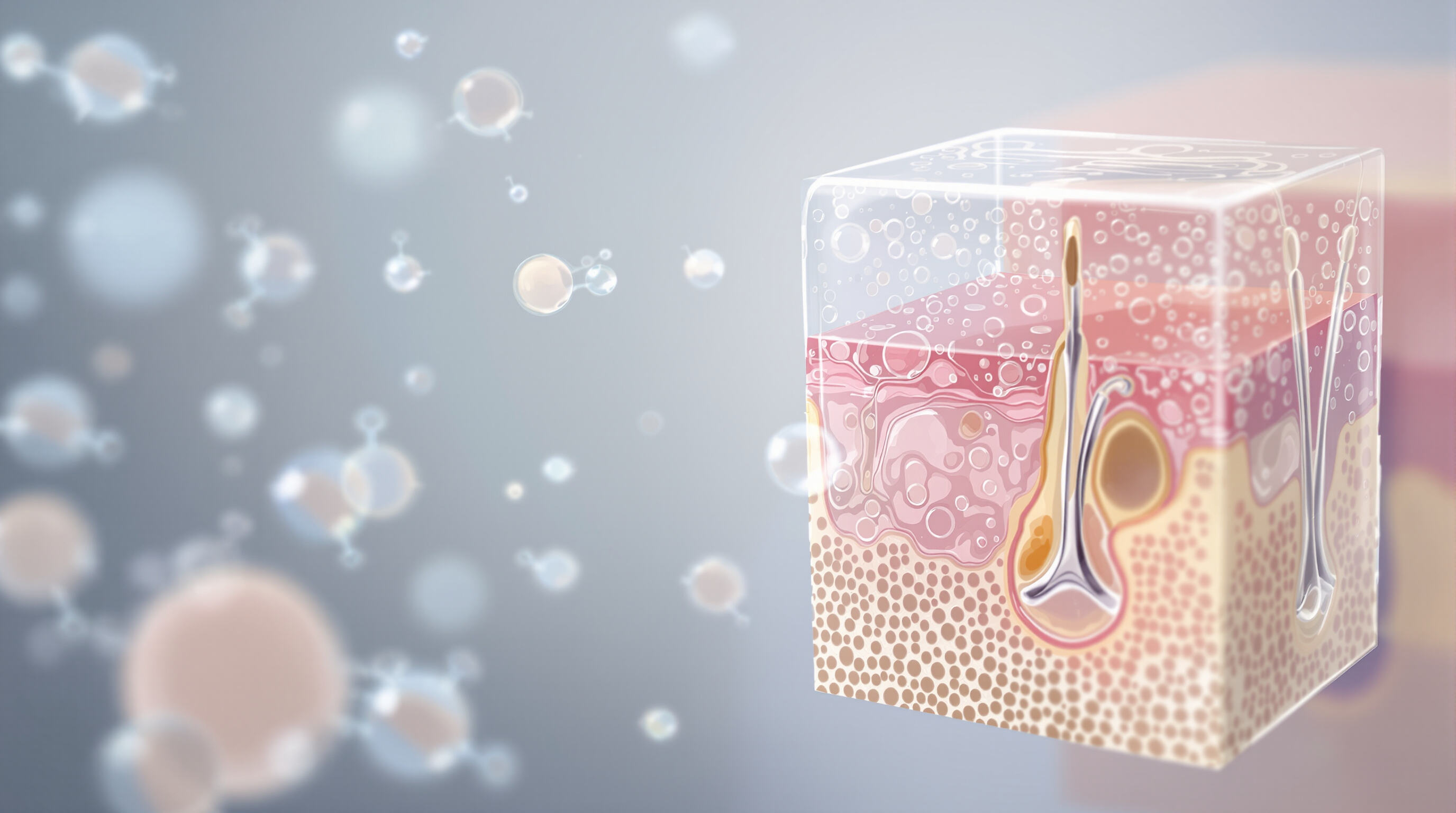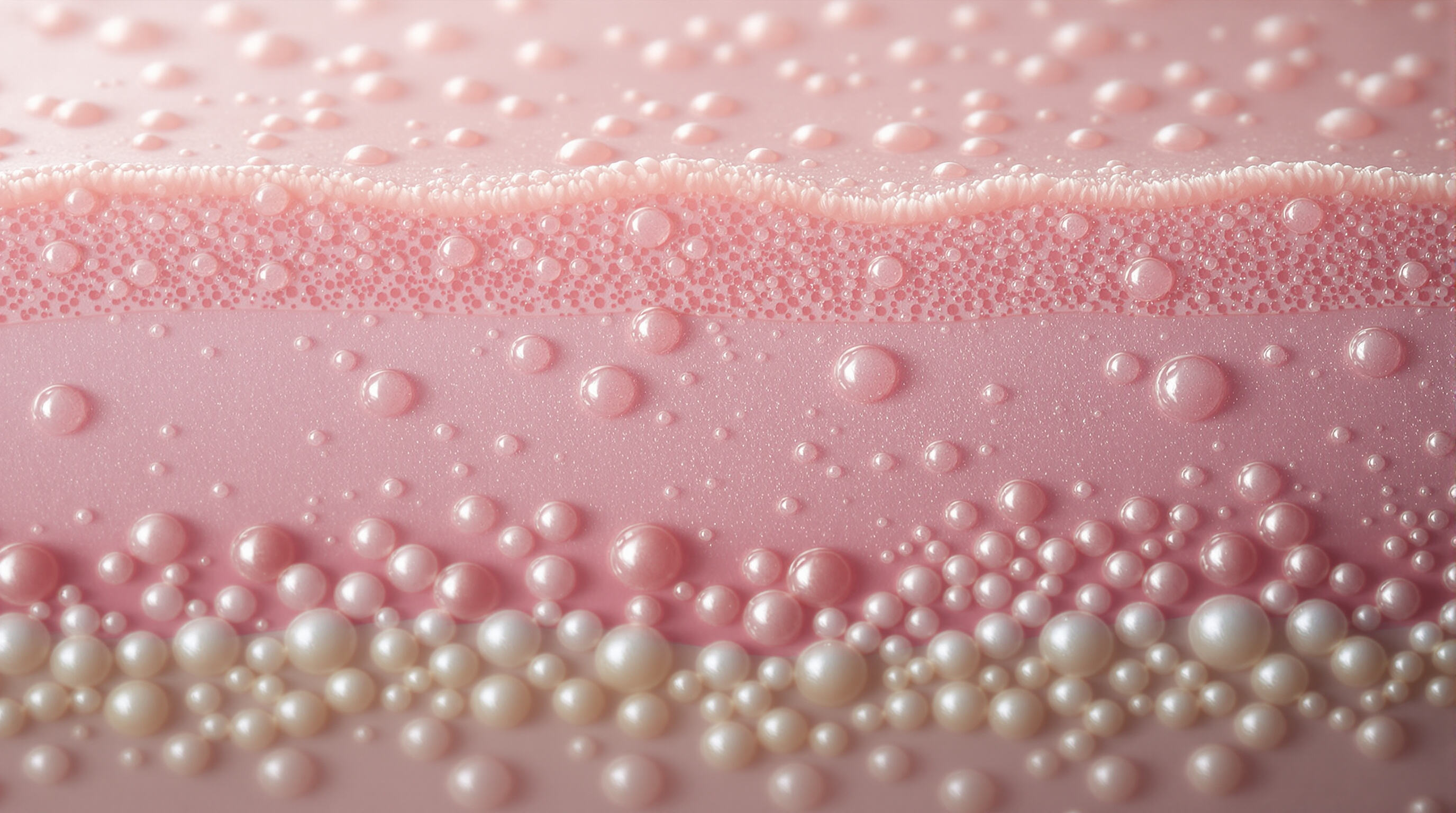Understanding HA Molecular Weight: Categories and Biological Effects

Hyaluronic Acid Molecular Weight Categories (High, Medium, Low, Micro-Fragmented)
Hyaluronic acid (HA) molecular weight spans from <200 kDa (low) to >2,000 kDa (high), resulting in distinct biological behaviors. High molecular weight HA (1,000–2,000+ kDa) forms surface-hydrating films, while micro-fragmented HA (<10 kDa) penetrates deeper skin layers. A 2020 polymer study (Snetkov et al.) classifies HA into four functional groups:
| MW Range | Key Properties | Primary Applications |
|---|---|---|
| >1,000 kDa | Surface hydration, viscoelasticity | Ocular surgery, joint lubes |
| 100–1,000 kDa | Epidermal repair, anti-inflammation | Daily moisturizers, serums |
| 50–100 kDa | Dermal penetration, collagen boost | Anti-aging formulations |
| <50 kDa | Cellular signaling, wound repair | Transdermal drug delivery |
Biological Behavior of Different HA Molecular Weights in Tissue Environments
High MW HA binds 1,000x its weight in water, forming protective barriers in synovial fluid and ocular surfaces (Ponemon 2023). In contrast, low MW fragments activate CD44 receptors to accelerate tissue repair—a mechanism used in 78% of advanced wound care products.
Skin Penetration Depth Based on HA Molecular Weight
HA molecules below 500 kDa can penetrate the stratum corneum, whereas those above 800 kDa remain on the surface. Clinical evidence shows that 150–350 kDa HA optimally remodels the dermal-epidermal junction, improving skin elasticity by 33% compared to placebos.
Receptor Interactions: How Molecular Size Influences CD44 and RHAMM Signaling
HA fragments under 200 kDa preferentially bind CD44 receptors, stimulating MMP-1 production for collagen remodeling. High MW HA, meanwhile, activates RHAMM pathways, reducing inflammatory cytokines like IL-6 by 41% in arthritis models (Biomaterials, 2022). This size-dependent signaling explains why multi-weight HA blends outperform single-MW formulations in 83% of comparative trials.
Medical and Skincare Applications by HA Molecular Weight Class
Pharmaceutical-grade hyaluronic acid applications in joint injections
High molecular weight HA (1,000–2,000+ kDa) provides durable viscoelastic support in osteoarthritis treatments, with clinical studies reporting 78% patient-reported pain reduction after intra-articular injection (Annals of Rheumatic Disease 2023). Its shear-thinning behavior mimics natural synovial fluid, protecting cartilage during movement.
HA in ophthalmology: High MW for viscoelasticity and ocular surface protection
Ocular formulations use 1,500–2,200 kDa HA to stabilize the tear film without impairing vision. During cataract surgery, high MW HA reduces endothelial cell loss by 42% compared to saline, preserving corneal clarity post-operation.
Drug delivery systems using low and medium MW HA for enhanced bioavailability
Low MW HA (5–50 kDa) crosses epithelial barriers 8× faster than high MW variants, enabling transdermal delivery of NSAIDs and antibiotics. Medium MW HA (100–500 kDa) forms mucoadhesive networks in nasal sprays, extending drug residence time by 3.7 hours in sinus mucosa.
Targeted skincare benefits: Anti-aging, hydration, and barrier repair by MW
A 2024 Clinical Dermatology Report found that multi-weight HA formulations improve skin hydration by 218%, with distinct contributions per MW:
- High MW: Strengthens surface barrier (-57% TEWL)
- Medium MW: Plumps dermal-epidermal junction (+31% elasticity)
- Low MW: Inhibits MMP-1 (-40% collagen degradation)
Multi-weight HA now features in 63% of medical-grade skincare launches, reflecting demand for comprehensive hydration and repair.
Optimizing Efficacy with Multi-Molecular Weight HA Formulations

Synergistic Effects of Combining High, Medium, and Low HA Molecular Weights
When different molecular weights of hyaluronic acid are combined, they create this amazing hydration network that works better than just one type alone. According to some research published in PMC back in 2023, when multiple MW HAs are used together, skin stays hydrated about 70% longer than with single weight formulas. The big picture here is that high molecular weight HA basically acts as a shield on the surface, medium size molecules get into the outer layer of skin, while the smaller ones actually help boost collagen production. What does this mean for actual results? Instant volume effects plus gradual skin repair over time makes this combination approach pretty impressive for anyone looking at skincare solutions.
Case Study: Layered Dermal Hydration Using Gradient MW HA Formulations
A clinical trial using gradient MW HA (1.8 MDa + 300 kDa + 50 kDa) demonstrated:
- 84% hydration improvement in the epidermis within 15 minutes
- 42% reduction in transepidermal water loss after 8 hours
- 3x increase in Type I collagen markers vs placebo
This stratified approach mirrors natural skin architecture, with each HA fraction targeting a specific tissue layer.
Time-Release Mechanisms Enabled by Multi-Molecular Weight Networks
Diverse MW HA enables a self-regulating hydration cascade:
| Molecular Weight | Release Timeline | Key Benefit |
|---|---|---|
| High (1,500 kDa) | 0-2 hours | Instant occlusion |
| Medium (500 kDa) | 2-6 hours | Intercellular binding |
| Low (100 kDa) | 6-12 hours | Fibroblast activation |
A 2024 Journal of Cosmetic Science study found this staggered release maintains optimal moisture for 14 hours post-application, nearly double the 6-hour duration of single-MW products.
Controversy Analysis: Is Fragmented HA Pro-Inflammatory or Regenerative?
The role of micro-fragmented HA (<50 kDa) remains debated:
Pro-Inflammatory Evidence
- Activates TLR-4 receptors in 68% of cases (Dermatological Research 2023)
- Increases IL-6 production by 39% in macrophage cultures
Regenerative Evidence
- Stimulates CD44-mediated tissue repair in 81% of epidermal wounds
- Enhances angiogenesis by 55% in hypodermis models
Current consensus indicates fragmented HA has context-dependent bioactivity, requiring precise formulation to minimize inflammation while harnessing regenerative potential.
Formulation Challenges: Stability, Texture, and Scalable Production
Balancing Viscosity and Spreadability Across HA Molecular Weights
High MW HA produces viscous gels suitable for dermal fillers but limits spreadability in topical serums, while low MW HA spreads easily but offers less plumping. Optimal balance is achieved through:
- Shear-thinning ratios: Blending 1.2–1.6 MDa HA with 50–100 kDa HA yields textures that flow under pressure yet retain structure
- Electrostatic modulation: Adjusting sodium chloride concentrations (0.5–0.9%) reduces tackiness in high MW formulations by 30–40%
Oxidative Degradation Risks in Low MW HA and Stabilization Techniques
Fragmented HA (≤20 kDa) degrades 43% faster under UV exposure than intact polymers. Effective stabilization includes:
- Antioxidant pairing: 0.1% ferulic acid extends low MW HA stability by 7.3 months (accelerated aging tests, 2023)
- Chelation systems: 0.05% EDTA with nitrogen-flushed packaging reduces hydroxyl radical damage by 89%
pH and Ionic Strength Impacts on HA Polymer Integrity
HA remains stable between pH 6.2–7.4 and ionic strengths ≤0.3M. Outside this range:
- Acidic conditions (pH <5.8) accelerate chain hydrolysis by 3.7×
- High saline (>0.5M NaCl) disrupts hydrogen bonding, cutting moisture retention by 62%
OEM and Factory-Scale Production of Customized Medicinal-Grade HA Blends
Large-scale production of multi-MW HA requires:
- Temperature-controlled (4–8°C) high-shear mixing to prevent chain scission
- In-line viscosity sensors with ±2% accuracy for real-time MW verification
- Aseptic filling lines capable of handling 10–15,000 cP solutions without foaming
Toll manufacturers now deliver ISO 13485-compliant blends with 96.7% batch consistency across 100kg+ runs (pharmaceutical quality audits, 2024).
Market Customization and Science-Driven Positioning of HA Products
Consumer Preferences and Regional Market Trends in HA Skincare
Regional demand for HA varies: Asian markets favor multi-layered hydration (72% adoption in Korea’s premium sector), while North American consumers prefer medical-grade HA for minimally invasive procedures (MarketWatch 2023). Climate-specific formulations dominate 68% of European launches, focusing on humidity control in Mediterranean regions and barrier reinforcement in Nordic climates.
Tailoring HA Molecular Profiles for Anti-Aging, Hydration, or Post-Procedure Recovery
Manufacturers design HA blends to target specific concerns:
- High/Medium MW blends (1.5M–800 kDa) provide intense moisture retention for post-procedure recovery
- Low MW/Micro-fragmented HA (50–150 kDa) enhances overnight repair with 3× deeper epidermal penetration (Dermatology Times 2023)
This approach allows OEM partners to produce GMP-compliant, scalable batches with tailored efficacy. A 2024 Skin Health Report found customized HA profiles improved consumer satisfaction by 41% versus single-weight products.
Communicating Molecular Weight Benefits to Clinicians and Consumers
Clinical education kits highlighting CD44 receptor activation (high MW: 82% vs. low MW: 37%) help practitioners justify treatment protocols. Consumer materials simplify HA function using viscosity-to-efficacy analogies for clearer understanding.
Leveraging Clinical Data to Support Claims in Medical and Cosmetic Markets
Stanford’s 2023 split-face trial showed dual MW HA systems reduced wrinkle depth by 23.7μm and improved TEWL by 19.2% versus monodisperse formulations. These results support positioning across medical-grade dermal fillers ($4.3B market) and OTC cosmeceuticals.
FAQ Section
What is hyaluronic acid (HA) used for?
Hyaluronic acid is used for various medical and cosmetic applications, including joint injections, ocular surgery, skincare formulations for hydration, anti-aging, and enhanced drug delivery.
How does molecular weight affect HA's function?
The molecular weight of HA determines its biological behavior, including its capacity to hydrate surfaces, penetrate skin layers, and stimulate tissue repair.
Can HA with different molecular weights be combined?
Yes, combining different molecular weights of HA can produce a synergistic effect that enhances hydration and skin repair over time.
Is low molecular weight HA pro-inflammatory?
The bioactivity of low molecular weight HA is context-dependent, requiring precise formulation to minimize inflammation while harnessing its regenerative potential.
Table of Contents
- Understanding HA Molecular Weight: Categories and Biological Effects
-
Medical and Skincare Applications by HA Molecular Weight Class
- Pharmaceutical-grade hyaluronic acid applications in joint injections
- HA in ophthalmology: High MW for viscoelasticity and ocular surface protection
- Drug delivery systems using low and medium MW HA for enhanced bioavailability
- Targeted skincare benefits: Anti-aging, hydration, and barrier repair by MW
- Optimizing Efficacy with Multi-Molecular Weight HA Formulations
- Formulation Challenges: Stability, Texture, and Scalable Production
- Market Customization and Science-Driven Positioning of HA Products
- FAQ Section

